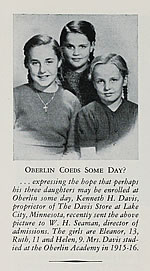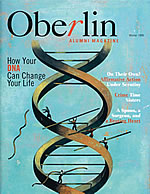Issue Contents :: Feature :: OAM - Celebrating 100 Years :: Page [ 1 2 3 4 5 ]
Oberlin Alumni Magazine: A Production Timeline
October 1904
Louis E. Lord ’97 and Helen White Martin ’87 are asked to edit an alumni page in the weekly Oberlin Review. The modest experiment was promising enough, in Lord’s opinion, to justify a separate monthly publication devoted to the interests of Oberlin’s scattered graduates. He and Martin become co-editors of the Alumni Magazine and work with eight associate editors to gather news. The monthly magazine is published by the Union Library Association, with yearly subscriptions sold for $1 (single copies for 15 cents). The magazine has two policies, as Lord later revealed: no pictures (too expensive) and no poetry (too dangerous).
December 1904
The magazine’s upstart faces many challenges, including continual errors that prompt this lengthy correction: “There were so many errors in our last issue that we feel that a public apology is due. We hope we have not entirely forfeited your confidence by this humiliating confession, and that we may obtain absolution at your hands for our sins, which indeed are many.”
1905
The Oberlin Alumni Magazine Publishing Company is formed, and 100 shares of stock are sold to alumni and faculty at $10 each. Stocks were paid back in subscriptions, which allowed the editors a $75 annual salary. Mainstay features include
a “Question Box” directed to the College president. OAM prints its first book review: Rational Living by President Henry Churchill King.
1906
The magazine’s redesigned cover depicts a coin-sized medal engraved with the silhouette of John Frederick Oberlin, a cover image that remains unchanged—with few exceptions—for the next 18 years.
1907
Editors share their belief that the magazine should be the medium of expression of alumni opinion on College matters and urge alumni to write about college affairs, “as do Yale and Harvard alumni.”
1908
In response to pleas from alumni who want to read more about their classmates, a class secretary system is proposed, along with a strong solicitation for “personal items.”
1910
The magazine is criticized for its “unusual amount” of advertising, a practice that editors defend. “It is only through advertising that the magazine can be made a financial success.” Ads continue to run for several decades. OAM also announces a new Alumni Reading Room, a lounge for visiting alumni on the fourth floor of Carnegie, furnished for $1,000, thanks
to OAM’s “hard earned surplus of some five years.”
1911
The first “Memorial Minute” appears, announcing the death of Adelia Field Johnston ’56. Helen Martin becomes the new business manager, and Louis Lord continues as editor. A $400 traveling fellowship is established by the magazine’s publishing company to aid students with graduate study; Otis F. Curtis ’11 is the first recipient.
1914
R.H. Stetson ’93 becomes co-editor. The longstanding cover image is finally replaced, but only for one year.
1916
The OAM fellowship ends due to “lack of surplus.”
1918
A “Help Win the War Issue” is produced. Wartime conservation efforts decrease the magazine’s size by one-third, and the magazine loses half of its subscribers. Cleveland
Plain Dealer editorial writer Archer H. Shaw ’97 is named editor-in-chief.
1921
Stockholders dissolve the Oberlin Alumni Publishing Co., and the magazine becomes the official publication of the Alumni Association. Editors hope the change
will widen the circle of readership and improve quality. William S. Ament ’10 is named editor and manager. Subscriptions to OAM now include membership in the Alumni Association.
1925
John G. Olmstead ’06 is named editor and manager.
1928
A suggested-reading section, composed of professor-recommended books, appeals to “those who would continue their education.”
1935
Virginia VanFossan ’27 is named editor, succeeding Dorothy Hall ’27. Readers “are introduced to a new publication under an old title, modern in its appearance, more colorful in its layout and somewhat different in its aim.” The Alumni Council votes to accept cigarette advertisements.
1936
No More Cigarettes: “Because of what seems to be very widespread criticism of the cigarette advertising on the back of the Alumni
Magazine, the Alumni Council voted this June to reverse its decision of February 1935.” OAM wins a greatest improvement award from the National Alumni Council.
1937
The “Last Word” column is introduced. Editor Virginia VanFossan’s saucy personality is apparent in its first entry, which asks, “Can you blame a woman for wanting the last word?” A year later, VanFossan resigns as editor. In her closing letter she writes: “Yes, editing an alumni magazine has its problems. The hide becomes thicker and thicker, and after nine years of it, you wear the orchids and smile serenely when the pin jabs you. You’d like to be flip occasionally and call some alumnus by his first name, but no, that’s not dignified. Our best wishes to our successors and to our readers. May they suffer less in the next three years.”
1938
Carroll K. Shaw ’28 is named editor.
1941
The magazine generates more class news than any other magazine of its type, which
editors attribute to dedicated class correspondents. A new cover design debuts, with a cover story commemorating 50 years of football at Oberlin. Allen Bailey ’36 is named editor.
1942
A new “Oberlin in Uniform” section carries letters and photos from servicemen. Features include
a two-page cartoon titled “Adventures
of a Rookie” by Pvt. Paul B. Arnold ’41.
 1943 1943
Readers debate use of the word coed, which appears in a photo caption. “We women are not coeds,” writes Agnes Mastick ’92. “We are members of the student body.” The term is later defended by historian Robert Fletcher: “Most Oberlin girls are willing to bear the appellation.” Charles A. Mosher ’28 is named editor.
1949
The magazine wins three reporting awards plus a certificate honoring its “unusually meritorious work.” Ironically, the article announcing the news fails to mention the name of the competition or its sponsor. Luella McCalla ’48 is named editor.
1951
An increase in the cost of paper, materials, and salaries prompts the Alumni Board to raise the annual subscription rate to $3.50. Helen K. Hayslette ’46 is named editor.
1954
The magazine celebrates 50 years, and in a somewhat haunting conclusion states: “Let us hope that in 2004 this issue will be combed for information and quotes to instruct and amuse alumni who will be reading a bigger and better Oberlin Alumni Magazine on its Hundredth Anniversary.” Mercedes Holden Singleton ’26 is named editor.
1955
Oberlin’s grounds superintendent predicts that 95 percent of the campus’ stately elm trees will succumb to Dutch elm disease by 1975; consequently, the magazine’s long-running “Under the Elms” column will no longer be appropriate. “Like our new masthead?” asks the editor. “Mr. A.R. Tommasini, renowned magazine layout authority, designed it for us this June.”
1956
OAM’s student commentator section is refocused because “the campus has been pretty quiet.”
1957
As an experiment, College trustees agree to mail the magazine free of charge to alumni.
1966
Philip F. Tear ’43 is named editor.
1967
“Information Please…” a page dedicated to alumni questions about any subject pertaining to Oberlin is born, although short-lived. The magazine is printed using web offset, “the most modern and quickest means available.” Circulation exceeds 26,000.
1969
For the second time OAM is recognized by Newsweek for achievement in alumni publication content that relates the institution to public affairs.
1981
The Alumni Board permits the magazine to be published on its own—independent of the Alumni Association—on two conditions: that the Alumni Board retains the right to make recommendations regarding policies and operations, and that the Alumni Association is guaranteed sufficient space in the magazine to publicize matters of interest to it. The agreement resolves the longstanding difficulty of the Alumni Board in monitoring day-to-day operations of the magazine.
1984
Phil Tear retires after 18 years. Linda K. Grashoff is named editor, and the magazine undergoes a streamlined design and new masthead by Joan Anderson ’70.
1990
OAM becomes one of the few national magazines printed on recycled paper. With each issue, “51 trees are saved, along with 21,000 gallons of water, 60 taxpayer dollars, 12,306 kilowatts of energy, and we reduce solid waste by nine cubic yards.”
1991
Color is added to the inside pages, and alumni are asked to help fight pollution by sending their class notes via
e-mail: “We think we’re the first alumni magazine in the country to offer this option,” writes the editor.
1993
OAM becomes the first complete alumni magazine to be placed online, aided by Steve Hawley ’88, who helped create the software.
1995
Cynthia Nickoloff ’88 is named editor.
1998
OAM moves from Bosworth Hall to its present location in Daub House.
1998
Kelly Viancourt is named editor.
 1999 1999
OAM’s newest re-design includes a masthead change. The italicized red r, which offends some readers, is dropped in subsequent issues.
2001
OAM receives two Circle of Excellence Awards from the Council for Advancement and Support of Education (CASE): a silver medal in the Periodical Publishing Improvement category and a bronze in the College General Interest Magazines category.
2004
OAM celebrates its centennial year, a milestone reached
by less than 12 other alumni magazines nationwide.
Back to Top ^^
|






 1943
1943  1999
1999